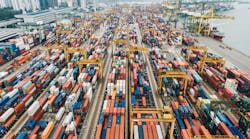A National Supply Chain Dashboard Could Prevent Bottlenecks—but It’s Not There Yet
The Covid-19 pandemic exposed Americans to severe shortages of toilet paper, paper towels, PPE, and semiconductor chips. Now, in November 2021, retailers and the public are dreading holiday shortages.
Making things worse, many of those toys, shoes and game consoles are within reach. As of early November, they were stored in nearly 500,000 containers carried by 100 container ships waiting to unload at the ports of Los Angeles and Long Beach.
How can this be happening? Can government help?
What’s Causing the Bottlenecks?
There is plenty of blame to go around, but no one has identified the bottleneck that is disrupting the flow of goods along the global supply chain. Some argue that Asian countries are having supply problems due to Covid-19 related safety policies such as partial closure of ports in China and lockdowns at factories in Vietnam.
On the home front, some suspect the logjam at the Los Angeles/Long Beach Ports has been due to the lack of automation and shortages of workers at the ports, containers, chassis for truckers to haul containers, truck drivers and warehouse operators.
Others believe that the snarled supply chain is caused by the lack of warehouse space to stores good: The warehouse vacancy rate in Los Angeles was only 1% in late October
A Government-Led Supply Chain Dashboard
Recognizing that resilient supply chains are essential to U.S. economic recovery, President Biden has engaged the entire government to address various supply chain challenges. Throughout history, no U.S. president has paid such close attention to supply chain issues.
In June, the White House released the 100-day reviews of supply chain risks in semiconductor manufacturing, high-capacity batteries, critical minerals and pharmaceuticals. Anticipating congestion at the ports along the West Coast, Biden appointed John Porcari as the White House port envoy in late August.
In late October, Biden quickly announced that the Long Beach, Calif., and Los Angeles ports would begin to operate 24 hours per day to ease port congestion.
Despite all these efforts, the flow of goods along the supply chain continued to be slow. To get operations moving smoothly, information for identifying the bottleneck is essential, so that the government can coordinate with trading partners including port operators, trucking companies, warehouse operators, etc.
To collect and share information, the White House announced on November 5 that it will develop a supply chain dashboard and share the information on a bi-weekly basis to track various operations along the supply chain.
Known as the Transportation Supply Chain Dashboard, the Biden-Harris Supply Chain Disruptions Task Force is measuring and tracking the status of the leading drivers of disruptions in our transportation and logistics supply chain. This dashboard tracks three important indicators of goods moving from ports to retail stores, including the number of containers imported, U.S. retailer inventory levels and on-the-shelf availability for consumer goods.
For example, on November 3, the dashboard reported that 379,000 containers arrived at various ports over a 2-week period. There was $455 billion of inventory held by US retailers, and on-the-shelf availability was 89%.
By sharing three key performance indicators on a bi-weekly basis, the dashboard is informative regarding the goods movement along the supply chain over the previous two weeks. However, this historical data cannot be used to predict the future.
Without real-time granular data, it is challenging for private companies to work with the ports to coordinate moving containers of goods from ships to docks to trains and trucks, to get goods distributed to warehouses, factories and stores.
This dashboard sets the right direction, but it does not provide the requisite information for different parties in the supply chain to coordinate and collaborate to improve supply chain efficiency.
To improve supply chain efficiency and resiliency, this dashboard must collect and share granular-level real-time data about container movements at the ports; train and truck movements to and from warehouses; and inventory movements to retailers. It is essential for the government to cooperate and collaborate with private companies to collect and aggregate this requisite data. Only by analyzing this data can one predict supply chain performance in the near future.
In the event that shortages appear to be imminent, the government and private companies can use this data to develop proactive plans to mitigate the risk of future disruptions. One possibility is to suspend labor laws including Assembly Bill 5—which recognizes some contract workers in California as full employees—during severe bottlenecks so that companies can hire more independent contractors such as truck drivers and warehouse workers to get the supply chain moving.
Ultimately, collecting and analyzing real time granular data will improve the supply chain dashboard.
Christopher Tang is a distinguished professor and the holder of the Carter Chair in Business Administration at the UCLA Anderson School of Management.




